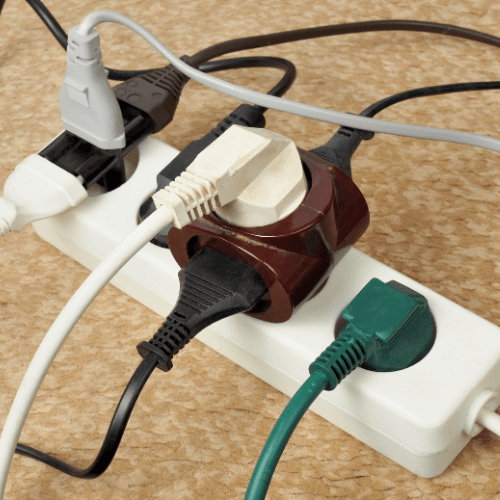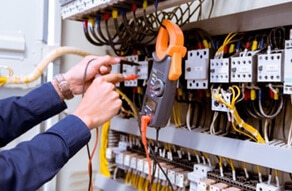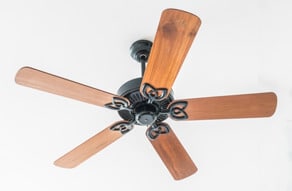Call us now
0439 823 190Electrical Overloading – Everything You Need To Know!
Posted on November 27, 2020

Electrical overloading occurs when there is too much power being drawn from the circuit. The electrical circuit overload can lead to serious issues and needs to be resolved quickly by an electrician. The Local Electrician is here with our Emergency Electrician team to help people when an electrical overloading emergency has occurred.
When electrical overloading happens, it is caused by too much electricity being used and the power is shut off. An overloaded circuit mostly results from multiple appliances using high amounts of electricity or that the system is too old. They can be prevented by undergoing regular electrical safety inspections, installing a proper circuit breaker and utilising dedicated circuits.
What is an Overloaded Electrical Circuit?
Electrical circuits include wiring, breakers or fuses and devices or appliances which run on electricity. If there is too much electricity running through the system then the circuit breaker will trip. If this happens the power to the system will be shut off until repairs are made.
Circuit breakers stop the power from exceeding and without the breaker shutting off all the power then the wires can overheat. As well as overheating, the insulation may melt which can open the wire and overall lead to an electrical fire.
How Does Electrical Overloading Usually Happen?
When the circuit breaker in the electrical switchboard has shut the power to a circuit then an overload has occurred. The more common reasons why overloading circuits occur are:
- Too many appliances – if there are multiple different appliances connected to one electrical circuit then the amount of power needed increases. The circuit might not be able or designed to handle the larger amount of electrical power. This circuit serving to provide electricity to appliances can be placed under higher levels of electrical loads, leading them to overload.
- Higher amp appliances – devices and appliances connected to an electrical system might need more amps to function. If too many appliances which have a higher amp level are used at once this can exceed the amperage. This most commonly occurs under the same power point, such as a kettle with a toaster used at once.
- Electrical faults – a fault within the circuit is another main cause for electrical overloading to occur. This electrical fault can be dangerous if not repaired quickly.
Extension cords and double adapters – when too many double adapters and extension cords are being used, especially when they connect off each other, this can be highly dangerous. For more information on if double adapters are safe, we highly recommend reading our blog with detailed information.
What are the Warning Signs of an Overloaded Electrical Circuit?
There are many different types of warning signs which a person can look for to identify if a circuit is overloading.
- Breaker tripping – this is the most obvious sign that an electrical overloading problem has occurred. The safety switch would be in the opposite direction to the others which indicates it has shut off the power.
- Dimming lights – lights dimming more often than it should is a clear indication of an electrical overload. When appliances are switched on and the lights dimmed, this means that those appliances are connected to the same circuit as the lights. This will draw more electricity and lead to an overload more commonly.
- Buzzing outlets or switches – if outlets and switches produce buzzing sounds then it is not normal. Often the buzzing might mean there is more electricity than usual.
- Warmer outlets or power points – when the outlets and power points are warm then this is a sign of electrical overloading. There might be too much electricity benign drawn out causing the outlets to be warm which it should not be.
- Smells and discolouration – outlets and power points can also hint of an overload if they smell unusual or are discoloured. It is important not to neglect this warning sign as the smell and discolouration are not normal.
How to Prevent Having an Overloaded Circuit?
There are many ways to avoid overloads in an electrical circuit by following the correct procedures.
- Routine Electrical Inspections – an electrical safety inspection will have a licensed electrician inspect all systems within the home. This includes the state of each electrical circuit, the electrical switchboard and the safety switches. It is important to have this inspection so an electrician can know if the system might overload early. Read more about how often to get an electrical inspection through our insightful blog.
- Inspect the Switchboard Regularly – when the qualified electrician is not performing inspections on all systems, a person should check their switchboard regularly. They are often found on the side or front of the house and contain the safety switches and circuit breaker. If the switch has been flipped or the system is not working, then these can be found before issues develop.
- Utilise Dedicated Circuits – it is extremely important that each system of the home has its own circuit. This means that the washing machine should not be connected to the same circuit as the fridge or dishwasher. This will help maintain a steady and safe electrical current and not need to draw our high amounts of power.
Avoid Double Adapters and Clutter – the use of double adapters can be safe but often people use too many which is dangerous. Also, in some areas of the home there are many appliances connected to one circuit, such as the kitchen, which can also lead to overloads. We encourage spacing out the appliances on different powerpoints and reading our blog on the benefits of installing USB powerpoints.
Who can Repair an Overloaded Circuit?
Here at The Local Electrician, we offer 24 hour electricians to work to resolve electrical overloading circuits. Our team understands how to operate on electrical systems safely while repairing the circuit in the shortest possible time.
We will work across all of Sydney, including the North Shore and Sutherland Shire, repairing overloads and inspecting circuits. Our Level 2 Electrician team is also specialists when it comes to performing more advanced electrical work and is here for everyone.

For reliable and professional electricians to repair an electrical overloading circuit – contact The Local Electrician now on 0439 823 190!
Lifetime Warranty on Workmanship and Labor
Our Services
Our skilled electricians are qualified to carry out any electrical repair or installation within Sydney. We strive to deliver absolute customer satisfaction by offering electrical services that are affordable, safe and long lasting.
- Private Power Pole Installation: What Sydney Homeowners Need To Know - November 29, 2023
- Understanding Power Outages: When To Call a Level 2 Electrician - November 14, 2023
- Understanding Level 2 Electrical Needs: FAQs for Sydney Homeowners - October 7, 2023
Our Level 2 Local Electrical Services










